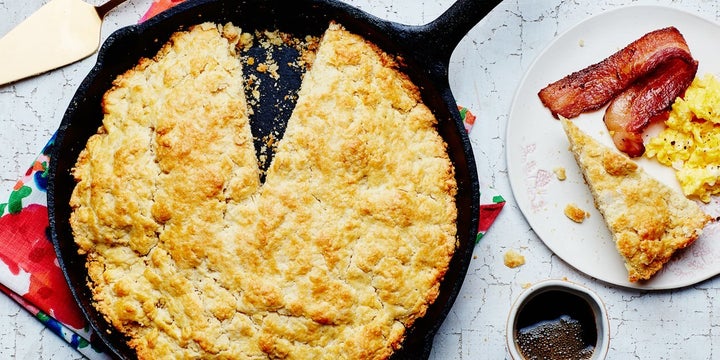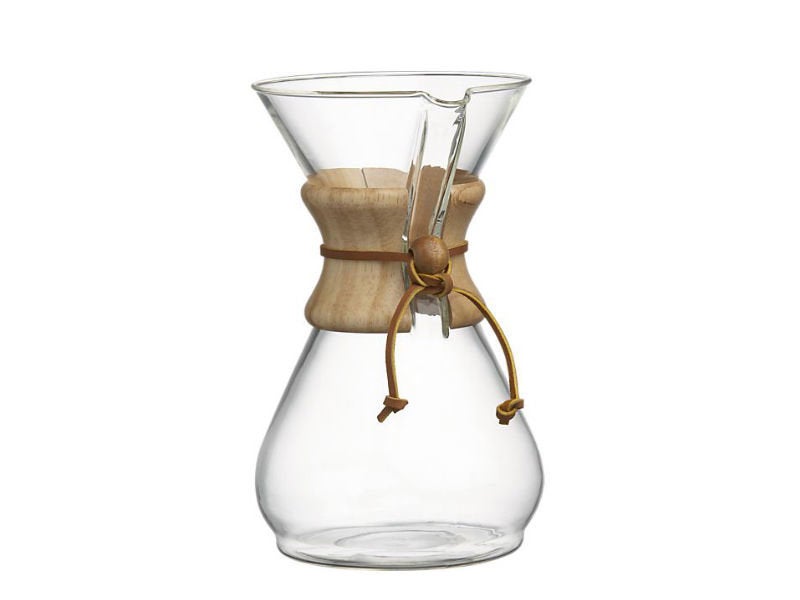For Epicurious, by Joe Sevier.

Maybe she overslept one morning and had to get breakfast on the table in a rush. Maybe the day’s trials had worn her out and the screaming kids were at her feet and the need for a buttery biscuit at the dinner table overshadowed her desire to not mess up the kitchen. Hell, maybe she just liked the way it looked. Whatever the reason, my great-grandmother — we called her Grandma Smith — is the person that introduced my mother, and subsequently me, to the idea of making one big biscuit for sharing instead of a bunch of individual biscuits.
It wasn’t the way she made biscuits every time. Unlike my Mamaw — my mother’s other grandmother — who formed her biscuits by hand, the same way I usually make biscuits to this day — Grandma Smith was known for her rolled-and-cut biscuits. But on occasion, instead of rolling out the dough out on a floured counter and cutting them into rounds one-by-one, she would dump that dough straight into a “black iron pan.” The dough would be quickly patted down to fit the pan, and then tossed into a blasting hot oven and her kitchen counters were blessedly ignorant of the mess they’d just narrowly avoided.
After it emerged from the oven, that giant, fluffy skillet biscuit was cut into wedges and served table-side, straight from the pan. Grandma Smith called it a hoecake — and despite the more popular cornmeal cakes that go by the same name, you’ll find many Southerners call these giant biscuits hoecakes, too.

When it comes to giant biscuits, there's no such thing as too much butter and jam.
Obviously, making one big biscuit instead of 12 smaller ones saves a ton of prep (and cleaning) time. And if you’re trying to turn out biscuits in a sweltering kitchen (for the record, my poorly ventilated NYC kitchen is always sweltering — even in January), it’s an especially good idea. The hotter your kitchen is, the easier it is for the butter to soften too quickly and dough to get overworked if you’re shaping individual biscuits. That means that the hands-off technique of the giant biscuit will deliver fluffier and flakier texture than individual biscuits, too.
What’s more, a big biscuit is also a pretty impressive way to serve this Southern staple for a crowd. My family always makes a skillet biscuit this way the day before Thanksgiving — not for breakfast though, instead it serves as the base for the turkey’s dressing, crumbled and cut by half with cornbread.
The best news? This skillet method will work with whatever biscuit recipe you already love (though I’m pretty partial to this one). Just butter the pan first, and add about 10 minutes to the baking time for a 12-inch cast-iron skillet. For a taller biscuit, you can use a 10-inch skillet — you might just need to bake it a bit longer due to the thickness. Chances are, if the top is nice and golden brown, the biscuit’s ready to come out of the oven. If you want to be doubly sure it’s ready, use an instant-read thermometer to test the middle of the biscuit, not touching the bottom of the pan (it should read between 200°F and 210°F).
For a super-luxe presentation, as in the photo above, split the biscuit in half like you would a cake. Since biscuits are a little more crumbly than cake, you’ll need to slide a thin, flexible plastic cutting board between the layers to lift the top away and to help you slide it back on once it’s been filled. But for my money, an easy, clean-sliced wedge of skillet biscuit tastes just as good when slathered with butter and jam—and then you can bring the piping hot skillet straight to the table, kitchen clean and intact—just the way Grandma Smith used to do it.
Get this recipe: Fluffy Cathead Biscuits with Honey Butter
More from Epicurious:

